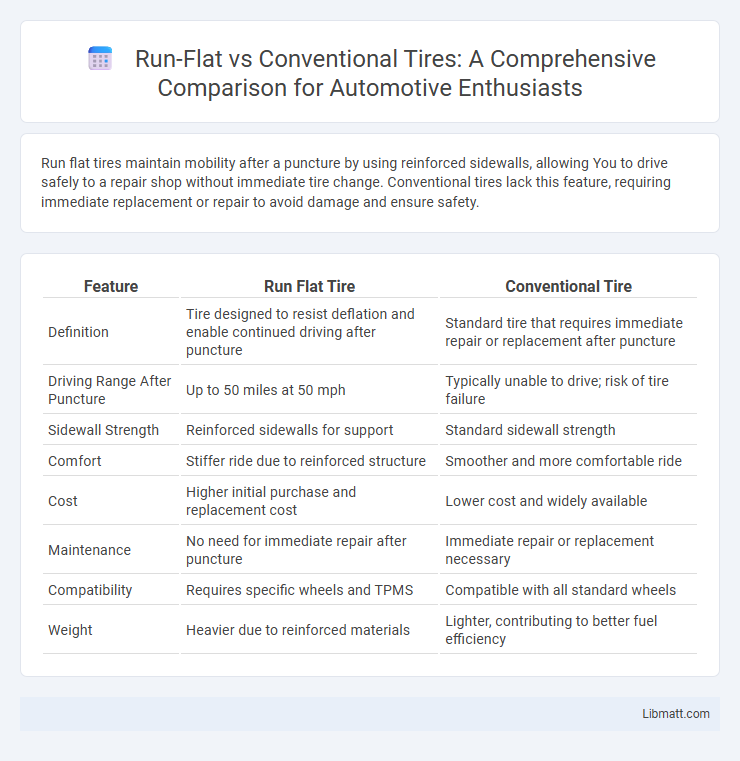Run flat tires maintain mobility after a puncture by using reinforced sidewalls, allowing You to drive safely to a repair shop without immediate tire change. Conventional tires lack this feature, requiring immediate replacement or repair to avoid damage and ensure safety.
Table of Comparison
| Feature | Run Flat Tire | Conventional Tire |
|---|---|---|
| Definition | Tire designed to resist deflation and enable continued driving after puncture | Standard tire that requires immediate repair or replacement after puncture |
| Driving Range After Puncture | Up to 50 miles at 50 mph | Typically unable to drive; risk of tire failure |
| Sidewall Strength | Reinforced sidewalls for support | Standard sidewall strength |
| Comfort | Stiffer ride due to reinforced structure | Smoother and more comfortable ride |
| Cost | Higher initial purchase and replacement cost | Lower cost and widely available |
| Maintenance | No need for immediate repair after puncture | Immediate repair or replacement necessary |
| Compatibility | Requires specific wheels and TPMS | Compatible with all standard wheels |
| Weight | Heavier due to reinforced materials | Lighter, contributing to better fuel efficiency |
Introduction to Run Flat and Conventional Tires
Run flat tires feature reinforced sidewalls designed to support the vehicle's weight even after air pressure loss, allowing temporary continued driving up to 50 miles at reduced speeds. Conventional tires rely on proper air pressure for structural integrity, requiring immediate repair or replacement upon deflation. The advanced construction of run flat tires offers enhanced safety and convenience compared to traditional tire technology.
Key Differences Between Run Flat and Conventional Tires
Run flat tires are designed with reinforced sidewalls that allow you to drive safely for up to 50 miles after a puncture, maintaining vehicle control without immediate replacement. Conventional tires rely on maintaining proper air pressure and require immediate repair or replacement following a puncture to avoid damage or loss of control. Understanding these key differences helps you choose the best option for safety, convenience, and driving performance.
Safety and Performance Comparison
Run flat tires offer enhanced safety by allowing you to maintain control and continue driving at reduced speeds after a puncture, significantly reducing the risk of accidents caused by sudden tire failure. Conventional tires may provide better ride comfort and handling under normal conditions but require immediate replacement or repair following a puncture, which can leave you stranded. The performance trade-off includes run flats typically having stiffer sidewalls that can slightly affect driving dynamics and fuel efficiency compared to conventional tires.
Ride Comfort: Run Flat vs. Conventional
Run flat tires generally provide a firmer ride compared to conventional tires due to their reinforced sidewalls designed to support the vehicle when air pressure drops, resulting in less absorption of road imperfections. Conventional tires offer superior ride comfort by flexing and cushioning more effectively over bumps and uneven surfaces, adapting better to road conditions. The trade-off between run flat and conventional tires lies in balancing safety and convenience with a smoother and more comfortable driving experience.
Tire Longevity and Durability
Run flat tires typically offer enhanced durability due to reinforced sidewalls designed to support the vehicle's weight even when air pressure is lost, resulting in reduced risk of tire damage during a puncture. Conventional tires may provide longer overall tread life under normal driving conditions, but they are more vulnerable to sidewall damage and sudden deflation, which can lead to shorter tire longevity. Investing in run flat tires can improve safety and maintain vehicle mobility, though tread wear rates are similar to conventional tires when properly maintained.
Cost Analysis: Upfront and Long-Term Expenses
Run flat tires typically have a higher upfront cost compared to conventional tires, often priced 20-40% more per unit due to specialized reinforced sidewalls. Long-term expenses for run flats may be lower since they reduce the need for spare tires and roadside assistance, but they can wear out faster and require specialized repairs, potentially increasing maintenance costs. Your choice impacts overall tire budget, balancing initial investment with potential savings in emergency services and replacement frequency.
Repair and Replacement Considerations
Run flat tires require specialized repair techniques and often need professional assessment before repairs, whereas conventional tires are more easily repaired due to standardized designs. Replacement of run flat tires can be more costly because of limited compatibility and fewer service options, while conventional tires offer a wider range of affordable replacements. Understanding these differences helps you make informed decisions about maintenance costs and service availability for your vehicle.
Availability and Vehicle Compatibility
Run flat tires are less widely available compared to conventional tires, often requiring specialized retailers or dealerships for purchase and installation. They are compatible primarily with vehicles equipped with tire pressure monitoring systems (TPMS) and reinforced sidewalls designed to support the car's weight after a puncture. Your choice depends on whether your vehicle supports run flats and if you prioritize convenience over broader availability.
Environmental Impact and Recycling
Run flat tires generally have a shorter lifespan and more complex construction than conventional tires, leading to increased environmental impact due to more frequent replacements and difficulties in recycling. Conventional tires are easier to recycle because their simpler design allows for more efficient processing into materials like rubber mulch or asphalt modifiers. Choosing conventional tires supports better resource recovery and reduces landfill waste, making them a more sustainable option in terms of environmental impact and recycling feasibility.
Choosing the Right Tire for Your Needs
Run flat tires provide the advantage of maintaining mobility after a puncture, allowing you to drive up to 50 miles at reduced speeds without immediate replacement. Conventional tires offer better ride comfort and typically cost less, but require swift repair or replacement once damaged. Your choice depends on your driving habits, safety priorities, and whether you value convenience over cost.
run flat vs conventional tire Infographic

 libmatt.com
libmatt.com